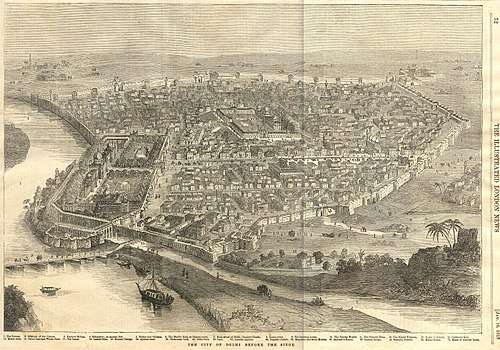Old Delhi
Old Delhi or Purani Dilli is an area part of the greater city of Delhi, India. It was founded as a walled city named Shahjahanabad in 1639, when Shah Jahan (the Mughal emperor at the time) decided to shift the Mughal capital from Agra.[1] The construction of the city was completed in 1648, and it remained the capital of the Mughal Empire until its fall in 1857,[1][2][3] when the British Raj took over as paramount power in India. It was once filled with mansions of nobles and members of the royal court, along with elegant mosques and gardens.
Old Delhi Purani Dilli | |
|---|---|
Municipality | |
 Old Delhi  Old Delhi | |
| Coordinates: 28°39′39″N 77°13′48″E | |
| Country | |
| Union Territory | Delhi |
| District | Central Delhi |
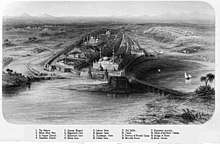
Despite having become extremely crowded and inundated today, it still serves as the symbolic heart of metropolitan Delhi and is known for its bazaars, street food, shopping locations and its Islamic architecture; Jama Masjid being the most notable example, standing tall in the midst of the old city. Only a few havelis are left and maintained.
Upon the 2012 trifurcation of the Municipal Corporation of Delhi, Old Delhi became administered by the North Delhi Municipal Corporation.[4][5]
History
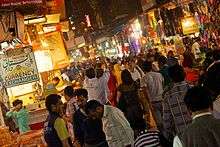
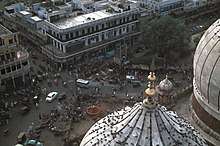

The site of Shahjahanabad is north of earlier settlements of Delhi. Its southern part overlaps some of the area that was settled by the Tughlaqs in the 14th century when it was the seat of Delhi Sultanate. The sultanates ruled from Delhi between 1206[6] and 1526, when the last was replaced by the Mughal dynasty.[7] The five dynasties were the Mamluk dynasty (1206–90), the Khalji dynasty (1290–1320), the Tughlaq dynasty (1320–1414), the Sayyid dynasty (1414–51), Lodi dynasty (1451–1526) and the Suri dynasty (1540-1556)
Delhi remained an important place for the Mughals, who built palaces and forts. Most importantly, Shah Jahan had the walled city built from 1638 to 1649, containing the Lal Qila and the Chandni Chowk. Delhi was one of the original twelve subahs (imperial Mughal provinces), renamed Shahjahanabad in 1648, bordering Awadh, Agra, Ajmer, Multan and Lahore subahs. Daryaganj had the original cantonment of Delhi, after 1803, where a native regiment of Delhi garrison was stationed, which was later shifted to Ridge area. East of Daryaganj was Raj ghat Gate of the walled city, opening at Raj Ghat on Yamuna River.[8] The first wholesale market of Old Delhi opened as the hardware market in Chawri Bazaar in 1840, the next wholesale market was that of dry fruits, spices and herbs at Khari Baoli, opening in 1850. The Phool Mandi (Flower Market) of Daryaganj was established in 1869, and even today, despite serving a small geographical area, it is of great importance due to dense population.[9]
After the fall of the Mughal Empire post 1857 revolt, the British Raj shifted the capital of British controlled territories in India to a less volatile city, Calcutta in Bengal, where it remained until 1911. After the announcement of the change, the British developed Lutyens' Delhi (in modern New Delhi) just south-west of Shahjahanabad. At this point, the older city started being called Old Delhi, as New Delhi became the seat of a national government. It was formally inaugurated as such in 1931.
Walls and gates
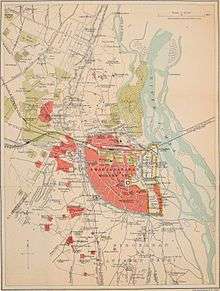
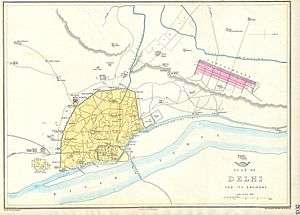
It is approximately shaped like a quarter cìrcle, with the Red Fort as the focal point. The old city was surrounded by a wall enclosing about 1,500 acres (6.1 km2), with 14 gates:[10]
- Nigambodh Gate: northeast, leading to historic Nigambodh Ghat on the Yamuna River
- Kashmiri Gate: north
- Mori Gate: north
- Kabuli gate: west
- Lahori gate: west close to the Sadar Railway station, Railway Colony, including the tomb of Syed Abdul Rehman Jilani Dehlvi.[11][12]
- Ajmeri Gate: southwest, leading to Ghaziuddin Khan's Madrassa and Connaught Place, a focal point in New Delhi
- Turkman Gate: southwest, close to some pre-Shahjahan remains which got enclosed within the walls, including the tomb of Shah Turkman Bayabani.
- Delhi Gate: south leading to Feroz Shah Kotla and what was then older habitation of Delhi.
The surrounding walls, 12 feet (3.7 m) wide and 26 feet (7.9 m) tall, originally of mud, were replaced by red stone in 1657. In the Mughal period, the gates were kept locked at night. The walls have now largely disappeared,[13] but most of the gates are still present. The township of old Delhi is still identifiable in a satellite image because of the density of houses.
The Khooni Darwaza, south of Delhi Gate and just outside the walled city, was originally constructed by Sher Shah Suri.
Streets and neighbourhoods
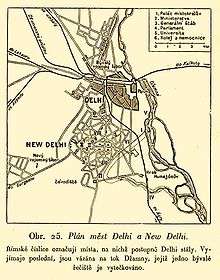
The main street, now termed Chandni Chowk, runs from the Red Fort to Fatehpuri Masjid. Originally a canal ran through the middle of the street.
North of the street, there is the mansion of Begum Samru, now called Bhagirath Palace. South of the street is Dariba Kalan, a dense residential area, beyond which is Jama Masjid. Daryaganj is a section that used to border the river at Rajghat and Zeenat-ul-Masjid.
The Urdu language emerged from the Urdu Bazaar section of Old Delhi. The Din Dunia magazine and various other Urdu publications are the reason for this language staying alive.[14]
Its main arteries are
- Netaji Subhash Marg / Bahadur Shah Zafar Marg leading to India Gate (north and south)
- Chandni Chowk/Khari Bawli Road (east and west)
Old Delhi is approximately bounded by these modern roads:
- Nicholson Road (north)
- Mahatma Gandhi Marg (east)
- Shraddhananda Marg (west)
- Jawaharlal Nehru Marg (south)
Old Delhi in 1876
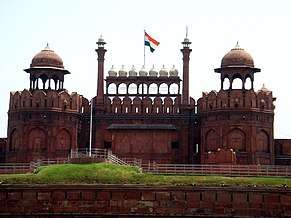
In 1876, Carr Stephen described the city as follows:[15]
Of the two streets described by François Bernier, the longer extended from the Lahore Gate of the city to the Lahore Gate of the citadel, and the other from the Delhi Gate of the city to the Lahore Gate of the fort. Both these streets were divided into several sections, each of which was known by a different name.
The section between the Lahore Gate of the fort and the entrance of the street called the Dariba, known as the Khuni Darwazah, was called the Urdu or the Military Bazaar; owing, very probably, to the circumstances of a portion of the local garrison having been once quartered about the place. Between the Khuni Darwazah and the present Kotwali, or the Head Police Station of the city, the street has the name of Phul ka Mandi or the flower market. The houses in front of the Kotwali were built at a short distance from the line of the rest of the houses in the street, to form a square.
Between the Kotwali and the gate known as the Taraiah, was the Jauhari or the Jewellers' Bazaar; between the Taraiah and the neighborhood is known as Asharfi ka Katra, was, par excellence, the Chandni Chowk. There was a tank in the center of the Chowk the site of which is now occupied by the Municipal Clock Tower, and beyond this to the Fatehpuri Masjid was the Fatehpuri Bazaar. The houses around Chandni Chowk were of the same height, and were ornamented with arched doors and painted verandahs. To the north and south of the square, there were two gate-ways, the former leading to the Sarai of Jehan Ara Begum, and the latter to one of the most thickly populated quarters of the city. Round the tank, the ground was covered with vegetable, fruit, and sweetmeat stalls. Over time the whole of this long street came to be known as the Chandni Chauk.
This grand street was laid out by Jahanara Begum, daughter of Shah Jahan. From the Lahore Gate of the fort to the end of the Chandni Chauk the street was about 40 yards wide and 1,520 yards long. Through the center of this street ran the canal of 'Ali Mardan, shaded on both sides by trees. On the eastern end of the Chandni Chauk stands the Lahore Gate of the Fort, and on the opposite end the handsome mosque of Fatehpuri Begam.
The clock tower no longer exists, although the location is still called Ghantaghar. The Sarai of Jehan Ara Begum has been replaced by the city hall. The kotwal is now adjacent to Gurdwara Sis Ganj Sahib.
In literature
| Wikisource has original text related to this article: |
The engraving accompanying Letitia Elizabeth Landon's poem The City of Delhi, appears to show the Jama Masjid with an elephant on the open ground before it. She associates the city's past glories with tales of enchantment, namely James Ridley's The Tales of the Genii (Sir Charles Mansell).
Historical sites
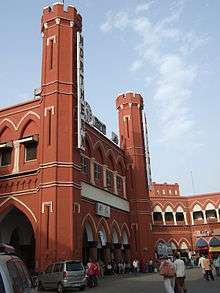
Many of the historical attractions are in the Chandni Chowk area and the Red Fort. In addition, Old Delhi also has:[16]
- Gurudwara Sis Ganj Sahib, a sikh Gurudwara built to commemorate the martyrdom site of the ninth Sikh Guru, Guru Tegh Bahadur. It marks the site where the ninth Sikh Guru was beheaded on the orders of the Mughal emperor Aurangzeb on 11 November 1675 for refusing to convert to Islam.
- Gaurishankar Temple
- Salimgarh Fort
- Mumtaz Mahal
- Gali Qasim Jan in Ballimaran is the site of Mirza Ghalib's haveli, and that of Hakim Ajmal Khan
- Razia Sultana's (Delhi's only female ruler before Indira Gandhi)— tomb near Kalan Masjid
- Jama Masjid, India's largest mosque
- Lal Mandir, Delhi's oldest Jain temple
- Fatehpuri Masjid
- Khari Baoli, Asia's biggest spice market
- Zinat-ul Masjid, Daryaganj built-in 1710 by one of Aurangzeb's daughters
- Rajghat, Mahatma Gandhi's cremation site memorial
- St. James Church (near Kashmiri Gate) built-in 1836, Delhi's oldest church, built by Col. James Skinner.[17]
Some of the historical mansions include:[18]
- Begum Samru's Palace of 1806 (see )now called Bhagirath Palace.
- Naughara mansions in Kinari Bazaar, 18th-century Jain mansions.
- Khazanchi haveli
- Masterji Kee Haveli, Sita Ram Bazar
- Haveli Sharif Manzil in Ballimaran is famous for its Aristocratic Hakims and their Unani practice, and that of Hakim Ajmal Khan
- Haveli of Mirza Ghalib, Gali Qasim Jan that is in Ballimaran
- Chunnamal haveli, Katra Neel
- Haveli of Zeenat Mahal, Lal Kuan Bazar
- Haksar Haveli, Bazar Sitaram, where Jawaharlal Nehru was married in 1916 to Kamla Nehru.
- Haveli Naharwali, Kucha Sadullah Khan, where Pervez Musharraf, former president of Pakistan was born
- Kucha Chelan (Kucha Chehle Ameeran), where the Persian descent inhabited
- Gurdwara Sis Ganj Sahib. Place where 9th Sikh Guru Guru Tegh Bahadur attained martyrdom.
Old Delhi cuisine

Old Delhi is well known for its cuisine. Old Delhi is the seat of the Mughal Empire for over two centuries has come to the modern hub of Mughlai cuisine. Karim's, a restaurant described as the city's most famous culinary destination, is near the Jama Masjid. The Gali Paranthe Wali and Ghantewala halwai are also situated here. Chawri Bazaar is one of the oldest markets in Delhi, dating back to the 17th century and was before known as a hardware market, but is known nowadays for its wholesale paper products.
Old Delhi is also known for its street food. Chandni Chowk and Chawri Bazaar areas have many street joints that sell spicy chaat (tangy and spicy snacks).
Culinary history
Old Delhi has certain identifiable landmarks of food. These include:
Paranthe Wali Gali
Pandit Gaya Prasad shifted from Agra to Delhi in 1876,[19] in search of a better life. In Delhi, he set up a single shop business selling hot paranthas. The product gained popularity to an extent where he has required the aid of his family members for help in the production. Eventually, Paranthe wali Gali, the lane in which the original shop was came to house 16 of them. It is now run by the families of Pandit Gaya Prasad and his relatives. The sixth-generation continues to run the four of the sixteen original shops that remain.
Karim's
Having been in the business of catering to Mughal Emperors, the family that runs it was displaced following the Revolt of 1857. In 1911, Haji Karimuddin moved back to Delhi with inspiration to open a Dhaba to cater to people coming to witness the coronation from all across the country. It was in 1913 that he established the Karim Hotel in Gali Kababian, Jama Masjid. Karim's exists here today to cater to the wants of people from all over the country and the world, being a major tourist attraction.[20]
Kallu Nihari
Nihari is a traditional meat stew that is slowly cooked to preserve its taste and the tenderness of its ingredients. Kallu Nihariwalla is a shop in Old Delhi that has served the dish exclusively since it was opened by the late Mohammed Rafiquddin (better known as Kallu Mian) in 1990. The shop, which is well known in the area, has served millions of portions.[21][22]
Harnarains
Harnarain Gokalchand was a pickle and murabba shop that was originally established in Khari Baoli by the name Harnarain Gopinath in 1857. It is often considered to be one of India's first commercially available pickle brands and was at the time India's largest food preservers. Their pickles and sharbat have been a household delicacy for over a century and a half, and have even served Jawaharlal Nehru and Indira Gandhi.[23] Having started from a small shop in Khari Baoli, Old Delhi, it has now become a global brand that goes by the name Harnarains International.
Banta
Characterised by a codd-neck bottle, Banta is a drink that has survived in Old Delhi since 1872.[24] The glass bottle in which this comes has a marble stopper, which is pushed into the bulbous neck of the bottle to unseal it. Engineer Hiram Codd patented the design of the bottle in 1872 in London to effectively seal fizzy drinks.[25]
The Banta bottles even contributed to the Indian National movement. This was so as protestors and rioters would often use these bottles as improvised cannons by adding calcium hydroxide to the mix. Thus, the bottles were banned in many cities across the country at some point before 1947.
Giani di Hatti
Located on Church Mission Road in the busy Fatehpuri Market of Old Delhi, Giani di Hatti was started by Giani Gurcharan Singh in 1951. Following partition, Giani Gurcharan Singh migrated from Layalpur, now in Pakistan, to Delhi.[26] He came while leaving an eatery there to start one here.
Arriving with his recipe for iced rabdi falooda, large crowds still flock to the shop to get a taste of that unique flavor. Apart from this, the shop also sells various fruit juices and an assortment of main dishes, not to mention over 50 flavors of ice cream.
Change in times can be recorded just by studying this shop as the same rabri falooda that was sold for 4 annas in 1951 is today sold for 80 Rupees.
The third generation of the family looks after the establishment now, which remains popular as ever, with visitors coming all the way to the market just to eat here. It's a great place.
Economic structure
Old Delhi has markets running through its streets. The area is vast and multiple products are being sold. Most of them are wholesale sellers and have been selling their products for many years. One such business is Gulab Singh Johrimal[27] was established in Dariba Kalan in 1816 mainly as an attar (perfume) manufacturing business. Since then they have diversified into compounding, incense and toilet soap manufacture. Their retail outlet in Chandni Chowk was started later on. Another such shop is Harnarains manufacturers of pickles and preserves, located in Khari Baoli. Under operation since 1944, it is one of the older shops currently located in Old Delhi. Some migrants sell products like clothes, fruits etc. The sellers of one product often form an association to serve their interests and negotiate with the local government and other official bodies. The Old Delhi area and its markets are governed by the Municipal Corporation of Delhi (MCD).[28]
Further reading
- Delhi, the emperor's city: rediscovering Chandni Chowk and its environs, by Vijay Goel. Lustre Press, 2003. ISBN 81-7436-240-1.
References
- Spear, Percival (2012). "Delhi: A Historical Sketch - The Mogul Empire". The Delhi Omnibus. New Delhi: Oxford University Press. p. 26. ISBN 9780195659832.
- History of Mughal Architecture By R. Nath, Abhinav Publications, 2006
- City of Djinns: A Year in Delhi By William Dalrymple, Olivia Fraser, HarperCollins, 1993
- Kavitha, Rao (8 October 2012). "Tragic chapter in an Old Delhi library's history". The National. Archived from the original on 15 February 2018. Retrieved 14 February 2018.
- "Remove overhead wires in old Delhi: North body". The Indian Express. 13 December 2017. Archived from the original on 11 October 2019. Retrieved 14 February 2018.
- Spear, Percival (2012). "Delhi: A Historical Sketch - The Delhi Sultanate". The Delhi Omnibus. New Delhi: Oxford University Press. p. 8. ISBN 9780195659832.
- Spear, Percival (2012). "Delhi: A Historical Sketch - The Fifteenth Century". The Delhi Omnibus. New Delhi: Oxford University Press. p. 23. ISBN 9780195659832.
- Fanshawe, p. 67
- Ashok Kumar Jain (2009). Urban transport: planning and management. APH Publishing. pp. 166, 176. ISBN 81-313-0441-8.
- http://www.milligazette.com/Archives/2004/01-15Jun04-Print-Edition/011506200496.htm Archived 19 June 2017 at the Wayback Machine Dilli's gates and windows By Mahtab Jahan
- Rehnuma-e-Mazaraat Delhi, Mohammad Asim-ul-Qadri Sanbhli, Mohammad Book Depot, 2007, Old Delhi India
- Sunbhli, Mohammad Asim Al-Qadri, 2007, Rehnuma-e-Mazaraat Delhi Sharif, Muhammadi Book Depot, 523 Waheed Kutb Market Matia Mahal Jamai Mosque, Delhi-6, India, p.p. 284
- Showers bring down ASI-protected wall in Old Delhi Archived 21 September 2013 at the Wayback Machine, ExpressIndia (web-site), The Indian Express, 2003-07-19
- Ghalib, 1797-1869: In 2vols.Vol.1, Life and Letters, By Mirza Asadullah Khan Ghalib, Ghalib, Asad-Allāh Ḫān Mīrzā Ġālib, Ralph Russell, Khurshidul Islam Published by Allen & Unwin, 1969
- Carr Stephen, Archaeology and Monumental Remains of Delhi (Author, 1876), pp. 246-47
- Old Delhi- 10 easy walks, by Malone Barton, 2006, South Asia Books
- The Last Mughal: The Fall of a Dynasty: Delhi, 1857, By William Dalrymple, Vintage, (March 11, 2008)
- Havelis of Old Delhi/Text by Pavan K. Varma and Sondeep Shankar. Reprint, first published in 1992. New Delhi, sexy, 1999
- "Why the 200-year-old taste shop won't budge - Times of India". The Times of India. Archived from the original on 17 January 2018. Retrieved 3 November 2017.
- "Enjoy The Royal Taste Of Mughlai Food With Karim's Food From India". www.karimhoteldelhi.com. Archived from the original on 7 November 2017. Retrieved 3 November 2017.
- "The Legacy of Kallu Mian, Old Delhi's Legendary Nihari Walla". NDTV Food. Archived from the original on 19 April 2018. Retrieved 18 April 2018.
- "Kallu Nihariwale (180, Chhatta Lal Mian, Jama Masjid, Behind Delite Cinema, Daryaganj, Delhi)". yummraj. 17 January 2015. Archived from the original on 19 April 2018. Retrieved 18 April 2018.
- "This sharbat is cool". Deccan Herald. 6 June 2012. Archived from the original on 6 February 2020. Retrieved 1 December 2019.
- "Banta: Why the street drink is still popular in Delhi". The Economic Times. Archived from the original on 7 November 2017. Retrieved 3 November 2017.
- "Pop culture - Livemint". www.livemint.com. Archived from the original on 13 September 2017. Retrieved 3 November 2017.
- "Giani Di Hatti – olddelhiheritage.in". olddelhiheritage.in. Archived from the original on 7 November 2017. Retrieved 3 November 2017.
- "Archived copy". Archived from the original on 19 September 2019. Retrieved 23 April 2020.CS1 maint: archived copy as title (link)
- "Archived copy". Archived from the original on 19 February 2017. Retrieved 24 April 2017.CS1 maint: archived copy as title (link)
Footnotes
- H.C. Fanshawe (1998). Delhi, past and present. Asian Educational Services. ISBN 81-206-1318-X.
- Stephen P. Blake (2002). Shahjahanabad: The Sovereign City in Mughal India 1639-1739. Cambridge University Press. ISBN 0-521-52299-4.
External links
| Wikimedia Commons has media related to Old Delhi. |
